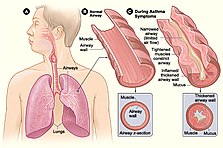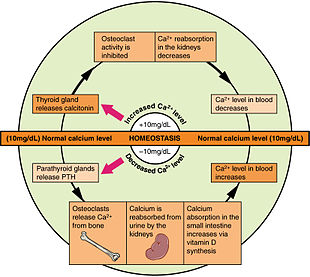We're for all- ALL are for us for the greater interest of Humanism-Truth-Facts-Friendship-Unity-Participation including Physico-Mental Sound Health with Spirituality, enrichment through ''TOTAL HEALTH SOLUTION'' to a Well-furnished GOALofTruth alloted for all in real sense ;
From wikipedia & other reliable sources ( Poets, Writers, Thinkers, Researchers, Free Lancers, Philosophers, Theologists, Scientists, Orators, Sociologists and Photographers +Artists-Musicians & etc.) we can learn as follows :
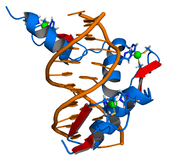

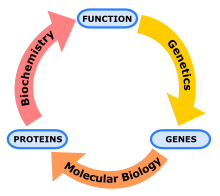
''Genetics is the study of genes, genetic variation, and heredity in organisms.[1][2][3] It is an important branch in biology because heredity is vital to organisms' evolution. Gregor Mendel, a Moravian Augustinian friar working in the 19th century in Brno, was the first to study genetics scientifically. Mendel studied "trait inheritance", patterns in the way traits are handed down from parents to offspring over time. He observed that organisms (pea plants) inherit traits by way of discrete "units of inheritance". This term, still used today, is a somewhat ambiguous definition of what is referred to as a gene.
জেনেটিক্স প্রাণী সমূহের বংশগতি ও অন্যান্য প্রাণীজ গুণাবলী বহন করে, তাই বেশীর ভাগ জেনেটিক জটিলতা হয়ে থাকে;
Trait inheritance and molecular inheritance mechanisms of genes are still primary principles of genetics in the 21st century, but modern genetics has expanded to study the function and behavior of genes. Gene structure and function, variation, and distribution are studied within the context of the cell, the organism (e.g. dominance), and within the context of a population. Genetics has given rise to a number of subfields, including molecular genetics, epigenetics and population genetics. Organisms studied within the broad field span the domains of life (archaea, bacteria, and eukarya).
Genetic processes work in combination with an organism's environment and experiences to influence development and behavior, often referred to as nature versus nurture. The intracellular or extracellular environment of a living cell or organism may switch gene transcription on or off. A classic example is two seeds of genetically identical corn, one placed in a temperate climate and one in an arid climate (lacking sufficient waterfall or rain). While the average height of the two corn stalks may be genetically determined to be equal, the one in the arid climate only grows to half the height of the one in the temperate climate due to lack of water and nutrients in its environment.
The molecular basis for genes is deoxyribonucleic acid (DNA). DNA is composed of deoxyribose (sugar molecule), a phosphate group, and a base (amine group). There are four types of bases: adenine (A), cytosine (C), guanine (G), and thymine (T). The phosphates make hydrogen bonds with the sugars to make long phosphate-sugar backbones. Bases specifically pair together (T&A, C&G) between two backbones and make like rungs on a ladder. The bases, phosphates, and sugars together make a nucleotide that connects to make long chains of DNA.[56] Genetic information exists in the sequence of these nucleotides, and genes exist as stretches of sequence along the DNA chain.[57] These chains coil into a double a-helix structure and wrap around proteins called Histones which provide the structural support. DNA wrapped around these histones are called chromosomes.[58] Viruses sometimes use the similar molecule RNA instead of DNA as their genetic material.[59]
DNA normally exists as a double-stranded molecule, coiled into the shape of a double helix. Each nucleotide in DNA preferentially pairs with its partner nucleotide on the opposite strand: A pairs with T, and C pairs with G. Thus, in its two-stranded form, each strand effectively contains all necessary information, redundant with its partner strand. This structure of DNA is the physical basis for inheritance: DNA replication duplicates the genetic information by splitting the strands and using each strand as a template for synthesis of a new partner strand.[60]

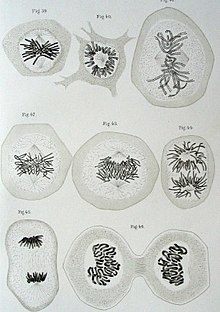
Genes are arranged linearly along long chains of DNA base-pair sequences. In bacteria, each cell usually contains a single circular genophore, while eukaryotic organisms (such as plants and animals) have their DNA arranged in multiple linear chromosomes. These DNA strands are often extremely long; the largest human chromosome, for example, is about 247 million base pairs in length.[61] The DNA of a chromosome is associated with structural proteins that organize, compact, and control access to the DNA, forming a material called chromatin; in eukaryotes, chromatin is usually composed of nucleosomes, segments of DNA wound around cores of histone proteins.[62] The full set of hereditary material in an organism (usually the combined DNA sequences of all chromosomes) is called the genome.
DNA is most often found in the nucleus of cells, but Ruth Sager helped in the discovery of nonchromosomal genes found outside of the nucleus.[63] In plants, these are often found in the chloroplasts and in other organisms, in the mitochondria.[63] These nonchromosomal genes can still be passed on by either partner in sexual reproduction and they control a variety of hereditary characteristics that replicate and remain active throughout generations.[63]
While haploid organisms have only one copy of each chromosome, most animals and many plants are diploid, containing two of each chromosome and thus two copies of every gene. The two alleles for a gene are located on identical loci of the two homologous chromosomes, each allele inherited from a different parent. [46]
Many species have so-called sex chromosomes that determine the sex of each organism.[64] In humans and many other animals, the Y chromosome contains the gene that triggers the development of the specifically male characteristics. In evolution, this chromosome has lost most of its content and also most of its genes, while the X chromosome is similar to the other chromosomes and contains many genes. This being said, Mary Frances Lyon discovered that there is X-chromosome inactivation during reproduction to avoid passing on twice as many genes to the offspring.[65] Lyon's discovery led to the discovery of X-linked diseases.[65]
Reproduction[edit]
When cells divide, their full genome is copied and each daughter cell inherits one copy. This process, called mitosis, is the simplest form of reproduction and is the basis for asexual reproduction. Asexual reproduction can also occur in multicellular organisms, producing offspring that inherit their genome from a single parent. Offspring that are genetically identical to their parents are called clones.[citation needed]
Eukaryotic organisms often use sexual reproduction to generate offspring that contain a mixture of genetic material inherited from two different parents. The process of sexual reproduction alternates between forms that contain single copies of the genome (haploid) and double copies (diploid).[46] Haploid cells fuse and combine genetic material to create a diploid cell with paired chromosomes. Diploid organisms form haploids by dividing, without replicating their DNA, to create daughter cells that randomly inherit one of each pair of chromosomes. Most animals and many plants are diploid for most of their lifespan, with the haploid form reduced to single cell gametes such as sperm or eggs.[citation needed]
Although they do not use the haploid/diploid method of sexual reproduction, bacteria have many methods of acquiring new genetic information. Some bacteria can undergo conjugation, transferring a small circular piece of DNA to another bacterium.[66] Bacteria can also take up raw DNA fragments found in the environment and integrate them into their genomes, a phenomenon known as transformation.[67] These processes result in horizontal gene transfer, transmitting fragments of genetic information between organisms that would be otherwise unrelated. Natural bacterial transformation occurs in many bacterial species, and can be regarded as a sexual process for transferring DNA from one cell to another cell (usually of the same species).[68] Transformation requires the action of numerous bacterial gene products, and its primary adaptive function appears to be repair of DNA damages in the recipient cell.[68]
Recombination and genetic linkage Thomas Hunt Morgan's 1916 illustration of a double crossover between chromosomes.
Thomas Hunt Morgan's 1916 illustration of a double crossover between chromosomes.
The diploid nature of chromosomes allows for genes on different chromosomes to assort independently or be separated from their homologous pair during sexual reproduction wherein haploid gametes are formed. In this way new combinations of genes can occur in the offspring of a mating pair. Genes on the same chromosome would theoretically never recombine. However, they do, via the cellular process of chromosomal crossover. During crossover, chromosomes exchange stretches of DNA, effectively shuffling the gene alleles between the chromosomes.[69] This process of chromosomal crossover generally occurs during meiosis, a series of cell divisions that creates haploid cells. Meiotic recombination, particularly in microbial eukaryotes, appears to serve the adaptive function of repair of DNA damages.[68]
The first cytological demonstration of crossing over was performed by Harriet Creighton and Barbara McClintock in 1931. Their research and experiments on corn provided cytological evidence for the genetic theory that linked genes on paired chromosomes do in fact exchange places from one homolog to the other.[70]
The probability of chromosomal crossover occurring between two given points on the chromosome is related to the distance between the points. For an arbitrarily long distance, the probability of crossover is high enough that the inheritance of the genes is effectively uncorrelated.[71] For genes that are closer together, however, the lower probability of crossover means that the genes demonstrate genetic linkage; alleles for the two genes tend to be inherited together. The amounts of linkage between a series of genes can be combined to form a linear linkage map that roughly describes the arrangement of the genes along the chromosome''.[72]
We're for all- ALL are for us for the greater interest of Humanism-Truth-Facts-Friendship-Unity-Participation to a Well-furnished GOAL of Truth from which all shall have ++++;
We're indebted to WIKIPEDIA +WHO for a short while and as 'Guardian QUOTATION' from Global WISER ONE. And have quoted many images, article's, writings etc. by great & humanist writers+++ from global thinkers, Well-wishers, Wiseman, Humanists and Others Living-Nonlivings in favor of HUMANISM to share more answers of Researchers-readers+++++....
To reach the 'GOAL of FULFILNESS' unitedly to alive in the "DESTINATION of TRUTH-FACTS-CHARMEST AMICABLITY" of Natural Joyful POSSIBILITIES+++
BREAST CANCER, TUMOR, Arsenic+Chemical Poisoning, Corona, Heart-Lung diseases, Neurological-Hormonal-Immunal-Infectious diseases with related complexities are possible to cure properly-easily-scientifically-accurately (100%) by our positive medical services only with+++++balance confirming
Medicine-Food control-proper nursing-medicinal massage-Medicinal Yogas- Meditation, Physiotherapy special etc. without side effects & Repeatation as per contract through user-friendly approved ways of CURE++++. please fill our form as below or click:
After confirming contract-letter between you+++. We serve you properly with no Chemo-therapy-radiation therapy -SURGICAL Complexities (Physical-Mental) to CURE+++ upto our Limit to recover your both-health from illness.


















